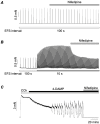Unravelling the Role of Post-Junctional M2 Muscarinic Receptors in Cholinergic Nerve-Mediated Contractions of Airway Smooth Muscle
- PMID: 40564919
- PMCID: PMC12192796
- DOI: 10.3390/ijms26125455
Unravelling the Role of Post-Junctional M2 Muscarinic Receptors in Cholinergic Nerve-Mediated Contractions of Airway Smooth Muscle
Abstract
It has long been recognised that airway smooth muscle cells (ASMCs) possess an abundance of M2 muscarinic receptors (M2Rs). However, the contribution of postjunctional M2Rs to contractions of airway smooth muscle (ASM) induced by the release of acetylcholine (ACh) from parasympathetic nerves was thought to be minimal. Instead, it was believed that these responses were exclusively mediated by activation of M3Rs. However, evidence is emerging that postjunctional M2Rs may have a greater role than previously realised. In this review, we discuss ACh signalling in airways, highlighting the well-established autoinhibitory role of prejunctional M2Rs and the putative roles of postjunctional M2Rs to cholinergic contractions of ASM. The cellular mechanisms that underpin M2R-dependent contractions of ASM are reviewed, with a particular emphasis on the role of ion channels in these responses. The regulation of M2R signalling pathways by β-adrenoceptor activation is also considered, along with the potential involvement of postjunctional M2Rs in airway diseases such as asthma and chronic obstructive pulmonary disease (COPD).
Keywords: COPD; airways; cholinergic; contraction; muscarinic; smooth muscle.
Conflict of interest statement
The authors declare no conflict of interest.
Figures






Similar articles
-
Role of voltage-gated Ca2+ channels and Ano1 Ca2+-activated Cl- channels in M2 muscarinic receptor-dependent contractions of murine airway smooth muscle.Am J Physiol Lung Cell Mol Physiol. 2025 Feb 1;328(2):L301-L312. doi: 10.1152/ajplung.00188.2024. Epub 2025 Jan 8. Am J Physiol Lung Cell Mol Physiol. 2025. PMID: 39772966
-
Contribution of Postjunctional M2 Muscarinic Receptors to Cholinergic Nerve-Mediated Contractions of Murine Airway Smooth Muscle.Function (Oxf). 2021 Oct 20;3(1):zqab053. doi: 10.1093/function/zqab053. eCollection 2022. Function (Oxf). 2021. PMID: 35330928 Free PMC article.
-
M2 Muscarinic Receptor-Dependent Contractions of Airway Smooth Muscle are Inhibited by Activation of β-Adrenoceptors.Function (Oxf). 2022 Sep 26;3(6):zqac050. doi: 10.1093/function/zqac050. eCollection 2022. Function (Oxf). 2022. PMID: 36325515 Free PMC article.
-
Comparison of the effectiveness of inhaler devices in asthma and chronic obstructive airways disease: a systematic review of the literature.Health Technol Assess. 2001;5(26):1-149. doi: 10.3310/hta5260. Health Technol Assess. 2001. PMID: 11701099
-
The Impact of Corticosteroids on Human Airway Smooth Muscle Contractility and Airway Hyperresponsiveness: A Systematic Review.Int J Mol Sci. 2022 Dec 4;23(23):15285. doi: 10.3390/ijms232315285. Int J Mol Sci. 2022. PMID: 36499612 Free PMC article.
References
Publication types
MeSH terms
Substances
Grants and funding
LinkOut - more resources
Full Text Sources

